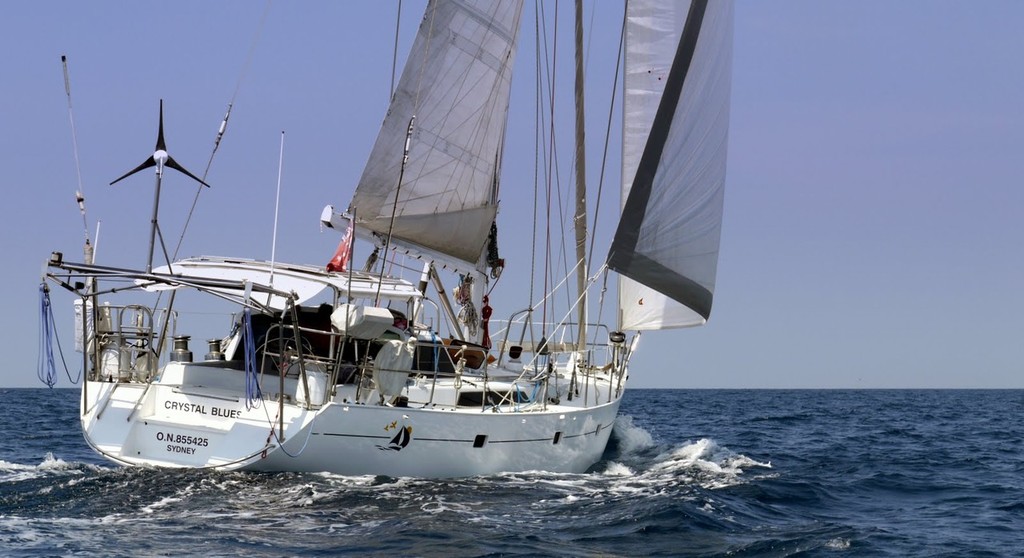Expose on EPIRBS - what price safety?
by Neil and Ley Langford on 19 Feb 2013

Crystal Blues sailing - photo by Neil Langford (in Dinghy) SW
Neil Langford, sailing with his wife Ley on Crystal Blues in Thailand, is considering crossing the Indian Ocean and reaching the Atlantic via Africa in a loose network of cruising sailors this year. While preparing, they have made some surprising discoveries about EPIRBs, which they share here:
Like many cruising sailors, in Asia we frequently look westward, hoping that the piracy problems will go away and allow us to continue our voyage towards Europe. Unfortunately the Indian Ocean and Gulf of Aden are still not safe, as confirmed in recent sailing advisories. There is a strong trend amongst cruising boats to travel westwards on a safer route, via Rodriguez, Mauritius, La Reunion, South Africa and the Cape of Good Hope. A loose but effective communication network has been established for those boats, supported with great energy by Richard & Susan Kidd on SV Sea Bunny, who are this year maintaining a list of vessels planning to head west, and sharing information on weather, anchorages, pilotage etc.
Here on Crystal Blues we're busy servicing and checking everything we need to cross oceans safely. As cruising sailors we absolutely depend on our primary safety tools - a sound vessel and responsible seamanship. However when things go really wrong we would turn to our secondary safety systems to help us out - life jackets, life rafts, radio communications and the Emergency Position Indicating Radio Beacon, or 406 EPIRB.
406 Emergency Beacons:
Ten years ago we invested significantly in the latest and greatest EPIRB, a 406mhz device with built in GPS, designed to alert the rescue services and tell them (accurately) where we were. It cost over $2,000.00 ! This year, we wanted to replace the battery, as required, preparing the unit for further service.
Here Is What We Found .....
First of all, a 'certified' new battery installation for our beacon, installed by the nominated agents in nearby Singapore, will cost around US$750.00. However, a brand new McMurdo 406 GPS EPIRB, a later generation with improved specifications, will cost about $20.00 less ! Other brands have similar options. Understandably, many cruisers are opting to buy the new product, though we've now found there is an attractive option. Our research has also uncovered some interesting gaps in our understanding and some surprises regarding the performance of existing EPIRB products!
Technology Changes - A New Generation Arrives:
An Australian company is now offering a fully COSPAS / SARSAT approved 406 GPS EPIRB for US$412.00 - quite a saving. The model number is Safety Alert SA1G, manufactured by Kinetic Technology, who make a range of location beacons and rescue transponders used by marine safety authorities and the military. They now offer a 406 GPS EPIRB with unique features that we think sailors will appreciate.
First and foremost, the battery has a claimed life of ten (yes 10) years, and the EPIRB has a ten year warranty. Secondly, the lithium battery is a special type and size that can be transported by air. Third, the unit has a 66 channel GPS receiver, accurate to 1.8 meters, though we're told the search and rescue authorities work to a minimum of 120 meters accuracy. It will also localise it's position in less than a minute. Finally, it works both IN or OUT of the water.
This last feature may seem strange, but we understand that most 406 EPIRBs use the water as a ground plane for their radio transmissions, and must be floating free to work correctly. The KTi unit doesn't require this, and can work on deck, in the life raft or on land. It may look a little retro, but this product seems to hit all the right buttons.
We love the 10 year battery service life, and the fact that we can fly the thing to us from the point of purchase. Or anywhere else for that matter. KTi General manager Mark Knowles tells me the unit will transmit its first burst to the satellite in less than 60 seconds, though the accurate GPS position may not be sent until the second burst, approximately 5 minutes later. The KTi unit then transmits a position update every 5 minutes, the maximum frequency allowed by the COSPAS / SARSAT authorities. We understand that alternative products do no better than once every 20 minutes.
This is where it gets interesting - KTi tell me they believe that while most (non KTI) 406 beacons do send a position transmission every 20 minutes, there are some well known brands that do not update the GPS position - they keep transmitting the original location fix, with no position update for the set and drift caused by wind, tide and currents. Surprised is an understatement here !
Predictably, we like the advanced capabilities of this new product - even though we hope never to use it ! The manufacturer will custom encode the unit to suit your national safety authority requirements, upon receipt of vessel registration papers and your MMSI number. Air freight delivery to Asia is quoted at A$80.00 We're ordering one this week.
You can follow the cruising life of Crystal Blues by http://svcrystalblues.blogspot.com.au/!clicking_here.
Did you like this article? Did you know that you can have all your non-competitive sailing news in one easy-read news magazine delivered direct to your inbox each week, simply by subscribing FREE to Sail-World Cruising? Stay up-to-date with what's happening on the water: everything from sailing adventures to new products, from rally news to new ideas and old tricks. Simply http://www.sail-world.com/CruisingAus/newsletter_subscribe.cfm!click_here now!
If you want to link to this article then please use this URL: www.sail-world.com/106711